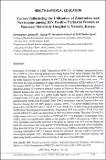Factors Influencing the Utilization of Zidovudine and Nevirapine among HIV Positive Perinatal Women at Pumwani Maternity Hospital in Nairobi, Kenya.

View/
Date
2014-01Author
Imbaya, Christopher L.
Odhiambo-Otieno, George W.
Okello-Agina, B.M.
Type
ArticleLanguage
enMetadata
Show full item recordAbstract
Prevention of Mother to Child Transmission (PMTCT) of Human Immunodeficiency Virus (HIV) is a key strategy aimed at protecting babies from being infected with HIV by their mothers. Treatment with combination rather than single Antiretroviral (ARV) drugs has been found to be more effective in PMTCT. The objectives of this study were: 1. to determine the rates of utilization of single drug and combinations of Zidovudine (AZT) and Nevirapine (NVP) for PMTCT and 2. To determine the factors that influence the choice of treatment among HIV positive perinatal women at Pumwani Maternity Hospital (PMH) in Nairobi, Kenya. This was a cross-sectional descriptive study. The study site was Pumwani Maternity Hospital, which is a public health facility on the eastern suburbs of Nairobi County. A total of 326 post natalHIV Positive women were sampled and administered with questionnaires either at the Postnatal Clinic (PNC) or postnatal ward in Pumwani Maternity Hospital. Among the 326 HIV positive women, 299(91.7%) acknowledged having been given ARV's for PMTCT where 160(53.5%) and 139(46.5%) of them were given single and combination drug treatments respectively. Single dose NVP was used by 132(44.1 %) of the women while AZT alone was prescribed in 28(9.4%) of the women. The other 139 (46.5%) of the women received a combination of NVP and AZT. The frequency of Antenatal Clinic (ANC) visits was significantly related to the number of ARV's dispensed (p=0.001). Late ANC attendance and health problems were given as reasons why AZT was not dispensed while the main reason that was cited for NVP not being used was the lack of its availability. More than half of the HIV positive women delivering at PMH received single drug PMTCT. Availing combination PMTCT therapy should be enhanced. Success could be realized by encouraging frequent ANC attendance, availing alternative ARV treatment options and addressing health conditions that contribute to the use of monotherapy.
Publisher
IJPP
Description
P 122-132
